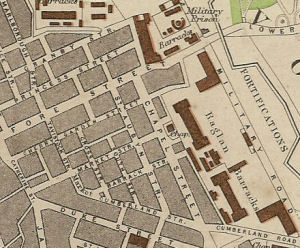|
OLD DEVONPORT
. UK |
||
|
© Brian
Moseley, Plymouth Webpage created: November 16, 2017 Webpage updated: December 28, 2018 |
||
|
ROADS AND STREETS IN OLD DEVONPORT CHAPEL STREET Chapel Street runs southwards from Fore Street to Cumberland Street and George Street.
Numbers 29 to 32, Chapel
Street, Devonport, 1942. A chapel was erected under the authority of a private Act of Parliament obtained in 1769. It was a chapel-of-ease to the Stoke Damerel Parish Church. The cost was raised by subscription and the Chapel took as its dedication the name of the Lord of the Manor, Saint Aubyn. The Chapel was completed in 1771. Chapel was Street was the second most important highway in the Borough. In addition to the Chapel it was the location of the Stoke Damerel Manor Office, the Stoke Damerel Parochial Office, the Jewish Synagogue as well as the offices of the Devonport Mercantile Association, the Devonport Permanent Benefit Building Society, the Devonport and Stonehouse Conservative and Unionist Association, and The Pearl Life Assurance Company Limited. The principal Licensed Landmarks in the Street were the Brown Bear Public House and the Crown Public House, the first property on the west side on the corner with Cumberland Street. At the "bottom" end in 1914 were a fruiterer, a confectioner, a cab proprietor, a milliner, a plumber, a hair dresser, an outfitter and a cycle agent. Josiah Clark and Son, the printer, and the Union Savings Bank and Government Annuity Institution were the principal businesses on the western side. The single tram line of the Plymouth, Stonehouse and Devonport Tramways Company ran through Chapel Street. From its opening in 1874 the trams ran into Fore Street up Chapel Street but when the line was electrified in 1901 the route was changed and the trams ran outwards towards East Stonehouse through the Street. In April 1930 Plymouth City Council planned to make Chapel Street one-way for all traffic in conjunction with Saint Aubyn Street, just as the tramways had always done.
|
||

